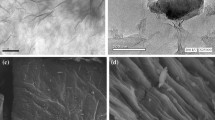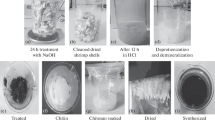Abstract
A novel chitosan-humic acid-graphene oxide (Cts-HA-GO) composite was produced and tested to remove hexavalent chromium (Cr(VI)) during the adsorption process. The percentage adsorption was 85.28% by using 200 ppm Cr(VI) and 2 g/L composite. Four hours of contact time was enough to remove Cr(VI) from the aquatic medium. The extent of adsorption of Cr(VI) on the surface of Cts-HA-GO composite was examined on the basis of increasing quantity of the composite. The functional group characterization and morphology of composite was characterized using scanning electron microscopy (SEM), energy-dispersive X-ray (EDX), X-ray diffraction (XRD), and Fourier transform infrared (FTIR) spectroscopy. After reaching the equilibrium, the residual concentration of the Cr(VI) solution was measured with an UV-visible spectrophotometer. The results showed that the adsorption behaviour was in accordance with the Langmuir isotherm model, and the maximum adsorption capacity of Cr(VI) determined by using this model was 83.64 mg/g at the pH of 2. A pseudo-second-order model equation has justified the equilibrium between Cr(VI) and the composite for the kinetic studies.

Graphical abstract











Similar content being viewed by others
Abbreviations
- Cts-HA-GO:
-
Chitosan-humic acid-graphene oxide
- Cr (VI):
-
Hexavalent chromium
- Cr (III):
-
Trivalent chromium
- Cts:
-
Chitosan
- GO:
-
Graphene oxide
- HA:
-
Humic acid
- EDX:
-
Energy-dispersive X-ray
- SEM:
-
Scanning electron microscopy
- FTIR:
-
Fourier-transform infrared spectroscopy
- XRD:
-
X-ray diffraction
- D-R isotherm:
-
Dubinin-Radushkevich isotherm
References
Altun T, Parlayıcı Ş, Pehlivan E (2016) Hexavalent chromium removal using agricultural waste “rye husk”. Desal Water Treat 57(38):17748–17756
Aydın YA, Aksoy ND (2009) Adsorption of chromium on chitosan: optimization, kinetics and thermodynamics. Chem Eng J 151:188–194
Bagheri M, Younesi H, Hajati S, Borghei SM (2015) Application of chitosan-citric acid nanoparticles for removal of chromium (VI). Int J Biol Macromol 80:431–444
Brose DA, James BR (2013) Hexavalent chromium reduction by tartaric acid and isopropyl alcohol in mid-Atlantic soils and the role of Mn(III,IV) (hydr)oxides. Environ Sci Technol 47:12985–12991
Budnyak TM, Pylypchuk IV, Tertykh VA, Yanovska ES, Kolodynska D (2015) Synthesis and adsorption properties of chitosan-silica nanocomposite prepared by sol-gel method. Nanoscale Res Lett 10(1):87
Dialynas E, Diamadopoulos E (2009) Integration of a membrane bioreactor coupled with reverse osmosis for advanced treatment of municipal wastewater. Desalination 238:302–311
Doke SM, Yadav GD (2014) Process efficacy and novelty of titania membrane prepared by polymeric sol-gel method in removal of chromium(VI) by surfactant enhanced microfiltration. Chem Eng J 255:483–491
Fares MM, Al-Ta’ani B (2003) Graft copolymerization onto chitosan: grafting of ethylmethacrylate using ceric ammonium nitrate as an initiator. Acta Chim Slov 50:275–285
Golbaz S, Jafari AJ, Rafiee M, Kalantary RR (2014) Separate and simultaneous removal of phenol, chromium, and cyanide from aqueous solution by coagulation/precipitation: mechanisms and theory. Chem Eng J 253:251–257
Gonçalves AC, Nacke H, Schwante D, Campagnolo MA, Miola AJ, Tarley CRT, Dragunski DC, Suquila FAC (2017) Adsorption mechanism of chromium(III) using biosorbents of Jatropha curcas L. Environ Sci Pollut Res 24:21778–21790
Habiba U, Siddique TA, Joo TC, Salleh A, Ang BC, Afifi AM (2017) Synthesis of chitosan/polyvinyl alcohol/zeolite composite for removal of methyl orange, Congo red and chromium (VI) by flocculation/adsorption. Carbohydr Polym 157:1568–1576
Heidari A, Younesi H, Mehraban Z (2009) Removal of Ni(II) Cd(II), and Pb(II) from a ternary aqueous solution by amino functionalized mesoporous and nano mesoporous silica. Chem Eng J 153:70–79
Ho YS, Ng JCY, McKay G (2006) Review of second-order models for adsorption systems. J Hazard Mater 136:681–689
Hsu NH, Wang SL, Lin YC, Sheng GD, Lee JF (2009) Reduction of Cr (VI) by crop-residue-derived black carbon. Environ Sci Technol 43:8801–8806
Hummers WS, Offeman RE (1958) Preparation of graphitic oxide. J Am Chem Soc 80:1339–1339
Karthik R, Meenakshi S (2014) Removal of hexavalent chromium ions from aqueous solution using chitosan/polypyrrole composite. Desal Water Treat 52:1–14
Kaya N (2017) A comprehensive study on adsorption behavior of some azo dyes from aqueous solution onto different adsorbents. Water Sci Technol 76(2):478–489
Kousaly GN, Gandhi MR, Meenakshi S (2010) Sorption of chromium(VI) using modified forms of chitosan beads. Int J Biol Macromol 47:308–315
Kulkarni PS, Deshmukh PG, Jakhade AP, Kulkarni SD, Chikate RC, Kulkarni PS, Deshmukh PG, Jakhade AP, Kulkarni SD, Chikate RC (2017) 1,5 Diphenyl carbazide immobilized cross-linked chitosan films: an integrated approach towards enhanced removal of Cr (VI). J Mol Liq 247:254–261
Kumirska J, Czerwicka M, Kaczyński Z, Bychowska A, Brzozowski K, Thöming J, Stepnowski P (2010) Application of spectroscopic methods for structural analysis of chitin and chitosan. Mar Drugs 8(5):1567–1636
Lagergren S (1898) About the theory of so-called adsorption of soluble substances. K Sven Vetensk Akad Handl 24:1–39
Logan EM, Pulford ID, Cook GT, MacKenzie AB (1997) Complexation of Cu2+ and Pb2+ by peat and humic acid. Eur J Soil Sci 43:685–696
Lu D, Kondamareddy KK, Fan H, Gao B, Wang J, Wang J, Hao H (2019) Highly improved visible-light-driven photocatalytic removal of Cr (VI) over yttrium doped H-titanate nanosheets and its synergy with organic pollutant oxidation. Sep Purif Technol 210:775–785
Mohan D, Pittman CU (2006) Activated carbons and low cost adsorbents for remediation of tri- and hexavalent chromium from water. J Hazard Mater 137:762–781
Niftaliyeva A, Pehlivan E, Polat S, Avci A (2018) Chemical synthesis of single-layer graphene by using ball milling compared with NaBH4 and hydroquinone reductants. Micro Nano Lett 13(10):1412–1416
Ohta A (2015) Speciation study of Cr in a geochemical reference material sediment series using sequential extraction and XANES spectroscopy. Geostand Geoanal Res 39:87–103
Ostovar F, Ansari R, Moafi HF (2017) Preparation and application of silver oxide/sawdust nanocomposite for chromium (VI) ion removal from aqueous solutions using column system. Global Nest J 19:412–422
Pakzadeh B, Batista JR (2011) Chromium removal from ion-exchange waste brines with calcium polysulfide. Water Res 45:3055–3064
Parlayıcı Ş, Pehlivan E (2017) Removal of metals by Fe3O4 loaded activated carbon prepared from plum stone (Prunus nigra): kinetics and modeling study. Powder Technol 317:23–30
Parlayıcı S, Yar A, Avci A, Pehlivan E (2016) Removal of hexavalent chromium using polyacrylonitrile/titanium dioxide nanofiber membrane. Desal Water Treat 57:16177–16183
Pehlivan E, Arslan G (2006) Comparison of adsorption capacity of young brown coals and humic acids prepared from different coal mines in Anatolia. J Hazard Mater 138:401–408
Shahriary L, Athawale AA (2014) Graphene oxide synthesized by using modified hummers approach. Int J Ren Energy Environ Eng 2(1):58–63
Shen J, Shi M, Li N, Yan B, Ma H, Hu Y, Ye M (2010) Facile synthesis and application of Ag-chemically converted graphene nanocomposite. Nano Res 3(5):339–349
Shu R, Zhang G, Zhang J, Wang X, Wang M, Gan Y, Shi J, He J (2018) Fabrication of reduced graphene oxide/multi-walled carbon nanotubes/zinc ferrite hybrid composites as high-performance microwave absorbers. J Alloys Compd 736:1–11
Singh V, Sharma AK, Sanghi R (2009) Poly (acrylamide) functionalized chitosan: an efficient adsorbent for azo dyes from aqueous solutions. J Hazard Mater 166(1):327–335
Srivastava S, Thakur IS (2006) Isolation and process parameter optimization of Aspergillus sp. for removal of chromium from tannery effluent. Bioresour Technol 97(10):1167–1173
Sun L, Fugetsu B (2013) Massive production of graphene oxide from expanded graphite. Mater Lett 109:207–210
Tytłak A, Oleszczuk P, Dobrowolski R (2015) Sorption and desorption of Cr (VI) ions from water by biochars in different environmental conditions. Environ Sci Pollut Res 22(8):5985–5994
Uyguner CS, Bekbolet M (2004) Evaluation of humic acid, chromium (VI) and TiO2 ternary system in relation to adsorptive interactions. Appl Catal B Environ 49:267–275
Varma AJ, Deshpande SV, Kenneddy JF (2004) Metal complexation by chitosan and its derivatives: a review. Carbohydr Polym 55:77–93
Wu Z, Li S, Wan J, Wang Y (2012) Cr(VI) adsorption on an improved synthesised crosslinked chitosan resin. J Mol Liq 170:25–29
Wu Y, Luo HJ, Wang H, Wang C, Zhang J, Zhang ZL (2013) Adsorption of hexavalent chromium from aqueous solutions by graphene modified with cetyltrimethylammonium bromide. J Colloid Interface Sci 394:183–191
Xu T, Xue J, Zhang X, He G, Chen H (2017) Ultrafine cobalt nanoparticles supported on reduced graphene oxide: efficient catalyst for fast reduction of hexavalent chromium at room temperature. Appl Surf Sci 402:294–300
Zhao G, Li J, Ren X, Chen C, Wang X (2011) Few-layered graphene oxide nanosheets as superior sorbents for heavy metal ion pollution management. Environ Sci Technol 45(24):10454–10462
Zhao TT, Ge WZ, Nie YX, Wang YX, Zeng FG, Qiao Y (2016) Highly efficient detoxification of Cr (VI) by brown coal and kerogen: process and structure studies. Fuel Process Technol 150:71–77
Zhao R, Li X, Sun B, Li Y, Li Y, Yang R, Wang C (2017) Branched polyethylenimine grafted electrospun polyacrylonitrile fiber membrane: a novel and effective adsorbent for Cr (VI) remediation in wastewater. J Mater Chem A 5(3):1133–1144
Author information
Authors and Affiliations
Corresponding author
Additional information
Responsible Editor: Domenico M. Doronzo
Rights and permissions
About this article
Cite this article
Parlayıcı, Ş., Avcı, A. & Pehlivan, E. Fabrication of novel chitosan-humic acid-graphene oxide composite to improve adsorption properties for Cr(VI). Arab J Geosci 12, 615 (2019). https://doi.org/10.1007/s12517-019-4828-8
Received:
Accepted:
Published:
DOI: https://doi.org/10.1007/s12517-019-4828-8




